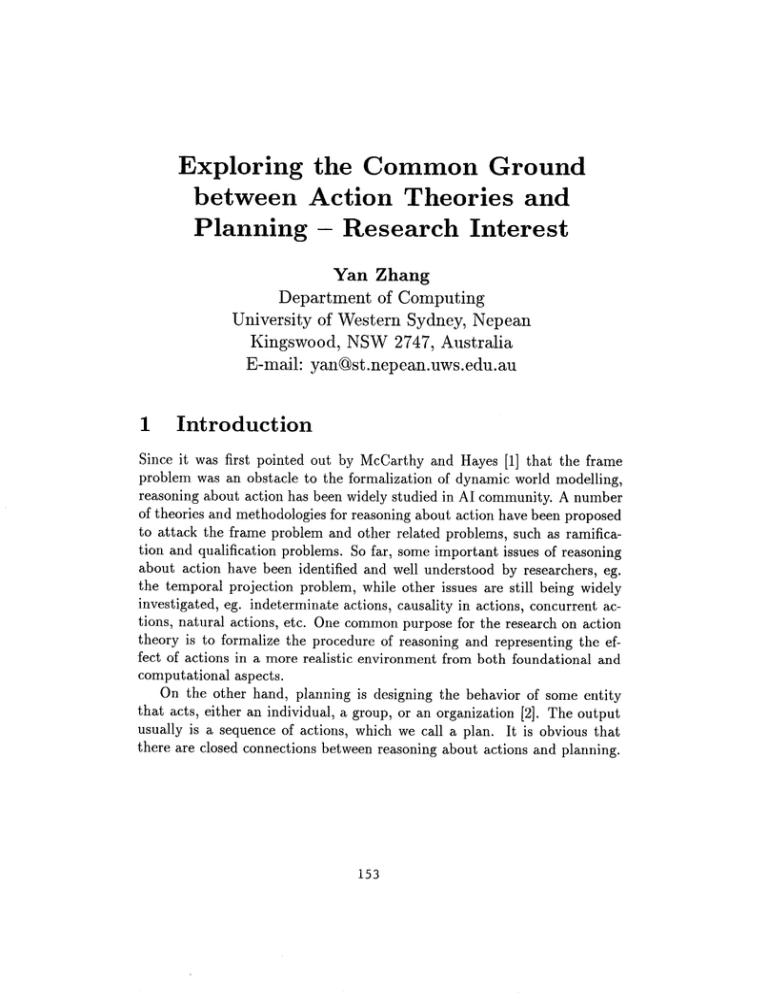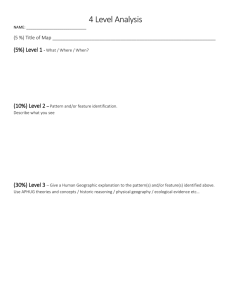Exploring the Common Ground between
advertisement

Exploring the Common Ground between Action Theories and PlanningResearch Interest Yan Zhang Department of Computing University of Western Sydney, Nepean Kingswood, NSW2747, Australia E-maih yan@st.nepean.uws.edu.au 1 Introduction Since it was first pointed out by McCarthy and Hayes [1] that the frame problem was an obstacle to the formalization of dynamic world modelling, reasoning about action has been widely studied in AI community. A number of theories and methodologies for reasoning about action have been proposed to attack the frame problem and other related problems, such as ramification and qualification problems. So far, some important issues of reasoning about action have been identified and well understood by researchers, eg. the temporal projection problem, while other issues are still being widely investigated, eg. indeterminate actions, causality in actions, concurrent actions, natural actions, etc. One commonpurpose for the research on action theory is to formalize the procedure of reasoning and representing the effect of actions in a more realistic environment from both foundational and computational aspects. On the other hand, planning is designing the behavior of some entity that acts, either an individual, a group, or an organization [2]. The output usually is a sequence of actions, which we call a plan. It is obvious that there are closed connections between reasoning about actions and planning. 153 For instance, it is essential to formalize the representation of actions before a planner can generate a plan for some goal. The classical planning system is the STRIPSin which actions are specified via pre-condition, add-list and delete-list. However,there are apparent gaps betweenthe research on these two areas. It has been shownthat the classical STRIPSplanning system is problematic with its semantics. Furthermore, it is not strong enough to represent more complex cases in reasoning about actions, eg. temporal reasoning, the state description with incomplete information, etc. Therefore, researchers on formal action theories seem more interested in using more powerful languages and reasoning mechanisms,eg. the situation calculus and non-monotoniclogics, to deal with the difficulties of reasoning about action. But, amongthese researches, relatively few work concerns the imlementation issue, which, on the other hand, is the key point in planning. Onthe other hand, in most of current planning systems, actions are still specified within the STRIPS-like schema. That is, these planning systems can only generate plans consisting of relatively simple actions although such planning systems are quite useful in some applications. One reason probably is from the implementation consideration. Other part of the reason, however, maybe the lack of knowingthe current research work on logics of actions. So, it is an important and interesting work to bridge the gap between these two research groups. 2 Research Interests Currently, my research interests focus on building the connections between formal actions theories and the STRIPS-likesystem. Specifically, two issues are investigated at the moment.The first is: deriving constraints from the STRIPS-like system. In formal action theories, domain constraints are usually specified as the background knowledgeand they have an important role in dealing with the ramification problem. In the STRIPS-like system, on the other hand, constraints are not explicitly represented. But, they are implicitly represented by actions’ pre-conditions and add-lists and delete-lists. It is not clear yet if such implicit constraints have the samerole as those in other action theories during state change. If the answer is yes, then is it possible to enforce the STRIPS’ expressibilities by adding some advanced features 154 of formal action theories. The other question I’m interested is: extending the STRIPS by combining some causal relations. Recent research has shown that in many circumstances, the traditional logic form of domain constraints is not appropriate for representing indirect effects of actions. I think it is possible to extend the STRIPS system by combining some kind of causal rules to capture the indirect effect of actions during the state change without violating the basic structure of the STRIPS. References [1] J. McCarthy and P. Hayes, Some philosophical problems form the standpoint of artificial intelligence. MachineIntelligence ,4, pp. 463-502. 1969. [2] D. McDermott and J. Hendler, Planning: What it is, what it could be, An introduction to the special issue on planning and scheduling. Artificial Intelligence, 76 pp. 1-16, 1995. [3] Y. Zhang, Compiling causality into action theories, In Proceedings of the Third Symposium on Logical Formalizations of Commonsense Reasoning (COMMONSENSE’96),pp. 263-270. Stanford, January 1996. [4] Y. Zhang and N.Y. Foo, Applying the persistent reasoning, Annals of Mathematics and Artificial 98, 1995. [5] Y. Zhang and formation. In Intelligence gust 1996 (to set approach in temporal Intelligence, 14, pp. 75- N.Y. Foo, Updating knowledge bases with disjunctive inProceedings of the lSth National Conference on Artificial (AAAI’96), Morgan Kaufmann, Inc. (1996). Portland, Auappear). [6] Y. Zhang and N.Y. Foo, Reasoning about persistence: a theory of actions, In Proceedings of the Thirteenth International Joint Conference on Artificial Intelligence (IJCAI’93), pp. 718-723, Morgan Kaufmann Publishers. Chambery, August 1993. 155



